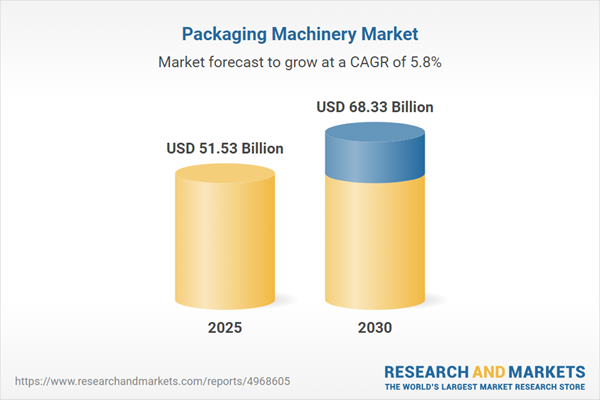Speak directly to the analyst to clarify any post sales queries you may have.
The packaging machinery market is experiencing fundamental change, shaped by digital transformation, sustainability requirements, and the need for resilient supply chains. Senior decision-makers require clear, actionable insights to navigate evolving industry dynamics and capitalize on new opportunities.
Packaging Machinery Market Snapshot
The global packaging machinery market grew from USD 48.74 billion in 2024 to USD 51.53 billion in 2025. It is expected to continue at a CAGR of 5.79%, reaching USD 68.33 billion by 2030. Market expansion is being propelled by automation investments, regulatory requirements, and a push for sustainable solutions. This report offers a comprehensive analysis of sector trends, growth drivers, and strategic shifts impacting industry participants.
Scope & Segmentation in the Packaging Machinery Market
- Machine Types: Capping machines (including crimp capping, screw capping, snap capping, spindle capping), cartoning machines (horizontal and vertical), filling machines (gravity, piston, rotary, volumetric), form, fill & seal machines, labelling machines (pressure sensitive, sleeve, wrap around), palletizing machines, wrapping machines (flow, shrink, stretch).
- Automation Levels: Fully automated, manual, and semi-automated equipment tailored for varying production needs.
- Packaging Types: Flexible packaging (bags, pouches, sachets), rigid packaging (bottles, boxes, cans, containers).
- Technologies: General packaging, modified atmosphere packaging, and vacuum packaging.
- Applications: Primary, secondary, and tertiary packaging to support diverse operational priorities.
- End-Users: Automotive, chemicals, cosmetics & personal care, e-commerce & logistics, electronics, food & beverage (bakery, beverages, dairy), pharmaceuticals (injectable, oral dosage, topical).
- Sales Channels: Offline and online distribution networks for flexible procurement.
- Regions: Americas (North America, Latin America), Europe, Middle East & Africa, and Asia-Pacific, each reflecting distinct regulatory landscapes and adoption curves.
- Major Companies Covered: ABB Ltd., Aagard Group, Accutek Packaging Company, Aetna Group, GEA Group, Fuji Machinery, Tetra Pak, MULTIVAC, ProMach, Krones, Syntegon Technology, and others driving innovation and regional expansion.
Key Takeaways for Senior Decision-Makers
- Industry 4.0 and digital innovations have transformed packaging machinery into data-driven platforms, allowing for predictive maintenance and real-time operational insights.
- Sustainability mandates are accelerating adoption of eco-design features, lighter materials, solvent-free cleaning, and modified atmosphere or vacuum technologies to reduce waste and emissions.
- Flexible and modular line designs support rapid response to shifting product mixes and seasonal demands, minimizing downtime and enabling faster time-to-market.
- Equipment suppliers are strengthening aftermarket support, digital upgrade offerings, and lifecycle management services to retain clients and drive recurring revenue.
- Regional variations drive demand for specific machinery types, such as high-speed solutions for North America and cost-effective, compact systems for Southeast and South Asia.
- Strategic collaboration—spanning materials science, software integration, and end-user partnerships—enhances market positioning and innovation potential.
Tariff Impact: Addressing New U.S. Tariff Regimes
Recent U.S. tariff measures on select packaging machinery imports have prompted manufacturers to adjust procurement and capital allocation strategies. Many are shifting toward local assembly and regional suppliers to offset rising costs. This trend is increasing focus on total cost of ownership and driving initiatives to extend machinery service life through refurbishment and proactive support programs. Organizations are also adopting dual-sourcing approaches and deploying digital twins to manage risk and maintain operational continuity.
Research Methodology & Data Sources
This report utilizes a mixed-methods research process. Secondary research reviewed industry publications, regulatory documentation, and specialist journals to frame technological and policy developments. Primary research included in-depth interviews and structured questionnaires with sector executives, production managers, and technical experts. Data triangulation and independent peer review validated findings and ensured actionable recommendations for packaging machinery stakeholders.
Why This Report Matters
- Informs executive planning with unbiased, up-to-date market intelligence tailored to strategic needs.
- Equips leaders to identify technology adoption priorities, optimize procurement, and build resilient, sustainable operations.
- Supports alignment of organizational strategy with rapidly changing regulatory and customer requirements worldwide.
Conclusion
The packaging machinery market is evolving as organizations balance innovation, regulatory shifts, and efficiency goals. This report delivers practical guidance to help leaders capitalize on automation trends, drive sustainability, and secure future competitiveness.
Additional Product Information:
- Purchase of this report includes 1 year online access with quarterly updates.
- This report can be updated on request. Please contact our Customer Experience team using the Ask a Question widget on our website.
Table of Contents
3. Executive Summary
4. Market Overview
7. Cumulative Impact of Artificial Intelligence 2025
Companies Mentioned
The companies profiled in this Packaging Machinery market report include:- Aagard Group, LLC
- Accutek Packaging Company, Inc.
- Aetna Group SPA
- ATP ENGINEERING AND PACKAGING SL
- B&H Labelling Systems
- Barry-Wehmiller Group, Inc.
- CKD Corporation
- Coesia S.p.A
- Combi Packaging Systems, LLC by SIAT Group
- Delkor Systems, Inc.
- Fuji Machinery Co., Ltd.
- GEA Group AG
- Honor Packaging Machinery Co., Ltd.
- IMA S.p.A.
- Ishida Co., Ltd.
- KHS Group by Salzgitter AG
- KOCH Pac-Systeme GmbH
- Krones AG
- Lantech.com, LLC
- Omori Machinery Co. Ltd.
- Optima Packaging Group GmbH
- Romaco Group
- ROVEMA GmbH
- Shikoku Kakoki Co.,Ltd.
- Spee-Dee Packaging Machinery, Inc.
- Syntegon Technology GmbH
- The Tetra Pak Group
- Viking Masek Global Packaging Technologies, Inc.
- Windmöller & Hölscher SE & Co. KG.
- Winpak Lane, Inc.
- HRS Process Systems Limited
- MULTIVAC Sepp Haggenmüller SE & Co. KG
- Marchesini Group S.p.A.
- Nichrome India Limited
- ABB Ltd.
- JBT Corporation
- BERHALTER AG
- CHLB Packing Machine Co., Ltd.
- KETE Group Limited
- PAC Machinery
- ProMach Inc.
Table Information
| Report Attribute | Details |
|---|---|
| No. of Pages | 182 |
| Published | November 2025 |
| Forecast Period | 2025 - 2030 |
| Estimated Market Value ( USD | $ 51.53 Billion |
| Forecasted Market Value ( USD | $ 68.33 Billion |
| Compound Annual Growth Rate | 5.7% |
| Regions Covered | Global |
| No. of Companies Mentioned | 42 |









